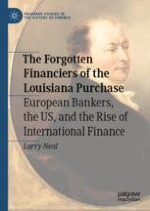2024 | OriginalPaper | Buchkapitel
2. Setting Up the Finance for the Louisiana Purchase
verfasst von : Larry Neal
Erschienen in: The Forgotten Financiers of the Louisiana Purchase
Verlag: Springer Nature Switzerland
Aktivieren Sie unsere intelligente Suche, um passende Fachinhalte oder Patente zu finden.
Wählen Sie Textabschnitte aus um mit Künstlicher Intelligenz passenden Patente zu finden. powered by
Markieren Sie Textabschnitte, um KI-gestützt weitere passende Inhalte zu finden. powered by
